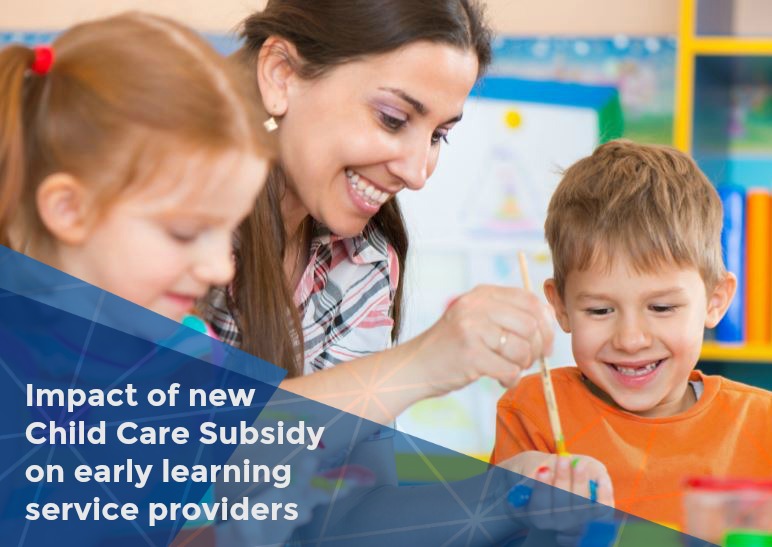
The early learning sector’s transition to the new Child Care Subsidy (CCS) has been unprecedented for all stakeholders in terms of the complexity of the new processes, the challenging timelines and the unexpected outcomes. For early learning service providers, the task of preparing themselves for the new system and seeking to understand the impact of the changes both operationally and on families has been all consuming.
ACA believes it is important to review the impact of the CCS to date and reflect on whether its implementation will improve early learning outcomes for children and families. Our aim is to identify areas for improvement, with a focus on equitable access to early learning for all Australian children as well as supporting the sustainability of the sector.
To this end ACA recently ran a survey targeted at Australia’s early learning service providers (ACA members and non-members) over the period of 6 July – 27 July 2018, with over 500 service providers contributung to the data.
The survey results confirmed the anecdotal feedback we had been receiving from ACA members regarding their experiences in this new space - the transition has been a huge challenge both operationally and in their engagements with families, with over 66% of service providers surveyed reporting that the transition had played out “not so well”or “terribly” for their service.
Operationally services were required to install new equipment, new software, new processes and of course train their staff. The difficulty service providers experienced in sourcing information prior to the implementation contributed to increased difficulties in ensuring that all elements of the transition were covered off.
A common theme from the survey results is third party software provider issues. It appears that the service provider’s impressions of how transition unfolded directly correlated with their experience with their software provider – this was a critical component to their experience of the transition.
Those services using software providers that were not adequately prepared for the new system experienced a raft of frustrating problems from not being able to determine the level of subsidy their families would receive (this had to be estimated or calculated manually) to not being able to invoice families correctly, and ultimately struggling to determine the ongoing viability of the service.
Across all government support services and software provider support services, resources were totally exhausted for the week leading into and the month following transition. This caused a significant sense of frustration for those administering the system as there was no quick way to get answers to the many questions and problems that needed addressing.
ACA appreciates the challenge for the Department of Education and Training to manage the development of the new IT infrastructure and associated support services, along with the task of ensuring that the third party software providers were adequately prepared for the new system. On balance, almost all services were able to lodge their sessions and receive subsidy payments in a timely manner.
However the survey results reveal that the general consensus among service providers is that the support they received from government didn’t come early enough and didn’t make it easy for services to find solutions to the roadblocks or problems they were experiencing.
In this context ACA’s educational materials were well received and seen to be supportive in the transition process.
An added layer to the challenges for service providers was the reality that the transition went far beyond new operational requirements and involved educating families about the new system - a task that many thought was not adequately achieved by government.
For many services this task even extended to directly assisting their families in the process of updating their details on MyGov. For those service providers with families from Non-English Speaking Backgrounds, some addressed the educational gaps by organising evening educational sessions with language translators present.
The feedback from service providers paints the picture that for families, the transition was equally challenging, with many struggling to understand the new activity test, what sort of activities would be eligible and what their new level of subsidy would be.
While seeking answers to these critical questions during the transition, many parents were frustrated by either not being able to get through to Centrelink on the phone, or being misinformed by Centrelink staff about key items such as how to correctly calculate activity hours, how to apply for the Additional Child Care Subsidy, and other detail around the policy.
The most outstanding miscommunication was the fact that the exemption to the activity test regarding the 36 hours per fortnight of subsidised hours (in centre-based preschool/kindergarten programs in the year before school) was not made clear to families in their Assessment Letters. This caused great confusion and was again compounded by Centrelink telephone staff misinforming many families about this exemption.
In terms of the impact on families, it is too early to determine how better or worse off families are. The survey results indicate that during the transition period more families were worse off than initially anticipated, but it is unclear whether this is a temporary result of transition or the overall impact of permanent changes.
Ultimately this change has been a long drawn out process rather than a single event, with the current transition period bringing on a greater understanding of the impact of the CCS. The early learning sector as a whole would concede that the previous subsidy model was highly flawed, complex and did not support affordability for families - an overhaul was undeniably necessary.
At this early stage it appears that the change to the CCS has not rectified all of the ills of the previous model. However, a good proportion of families are better off from an affordability perspective, which is an indisputable, fantastic outcome.
This must be reconciled however with the critical reduction in access for many vulnerable and disadvantaged children where a family does not meet the activity test requirements. It is vitally important that the capacity for these children to receive subsidised access to an early learning service extends beyond the parameters already allowed within the CCS.
To this end ACA continues to engage with government to ensure an equitable outcome for Australia’s youngest generation and facilitate a smoother, simpler system for all who engage with it.
ACA's full report The Impact of the transition of the new Child Care Subsidy on early learning service providers is available here.
Paul Mondo, ACA President







